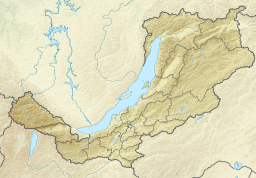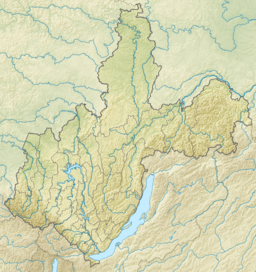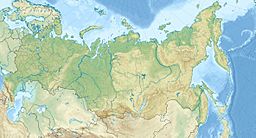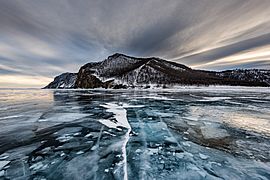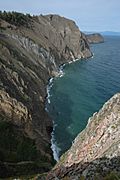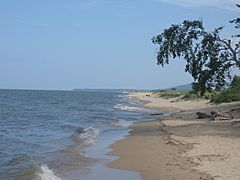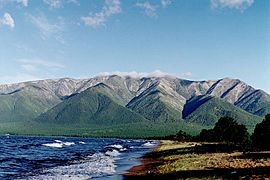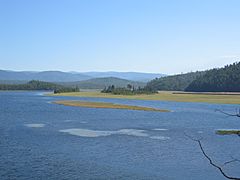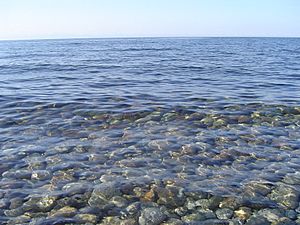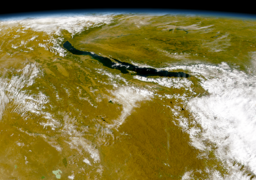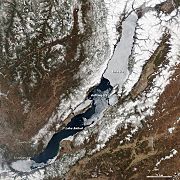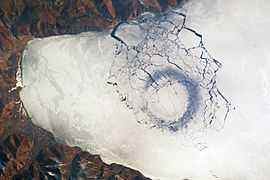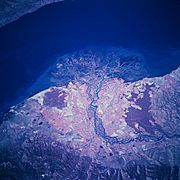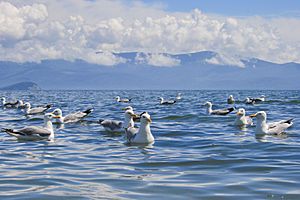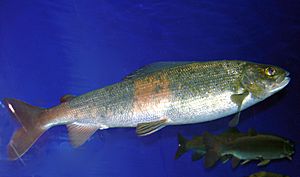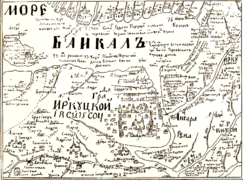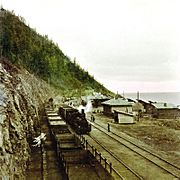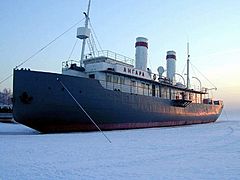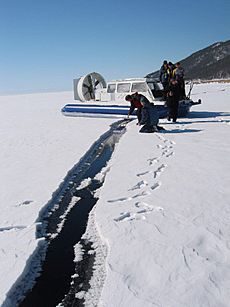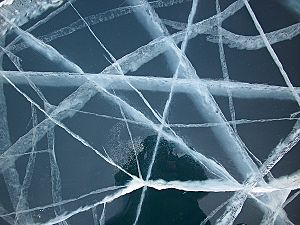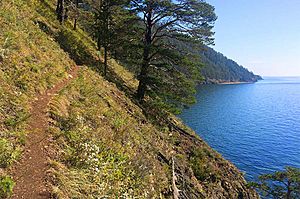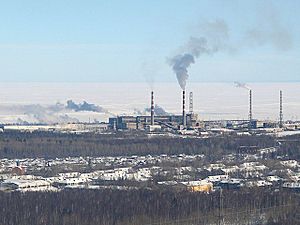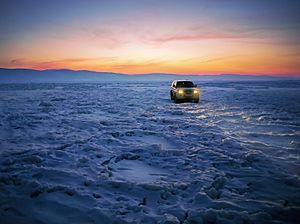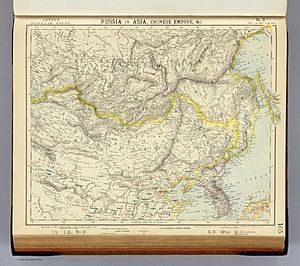Lake Baikal facts for kids
Quick facts for kids Lake Baikal |
|
|---|---|
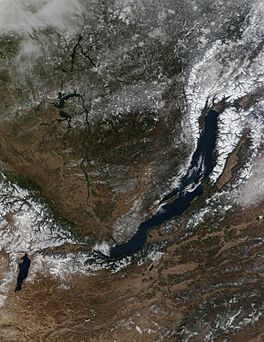
Satellite photo of Baikal, 2001
|
|
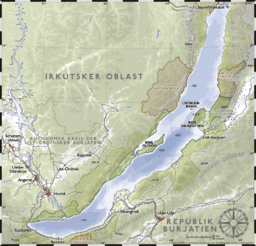 |
|
| Location | Siberia, Russia |
| Coordinates | 53°30′N 108°0′E / 53.500°N 108.000°E |
| Lake type | Ancient lake, Continental rift lake |
| Native name | |
| Primary inflows | Selenga, Barguzin, Upper Angara |
| Primary outflows | Angara |
| Catchment area | 560,000 km2 (216,000 sq mi) |
| Basin countries | Mongolia and Russia |
| Max. length | 636 km (395 mi) |
| Max. width | 79 km (49 mi) |
| Surface area | 31,722 km2 (12,248 sq mi) |
| Average depth | 744.4 m (2,442 ft; 407.0 fathoms) |
| Max. depth | 1,642 m (5,387 ft; 898 fathoms) |
| Water volume | 23,615.39 km3 (5,670 cu mi) |
| Residence time | 330 years |
| Shore length1 | 2,100 km (1,300 mi) |
| Surface elevation | 455.5 m (1,494 ft) |
| Frozen | January–May |
| Islands | 27 (Olkhon Island) |
| Settlements | Severobaykalsk, Slyudyanka, Baykalsk, Ust-Barguzin |
| UNESCO World Heritage Site | |
| Criteria | Natural: vii, viii, ix, x |
| Inscription | 1996 (20th Session) |
| Area | 8,800,000 ha |
| 1 Shore length is not a well-defined measure. | |
Lake Baikal (Russian: Oзеро Байкал, romanized: Ozero Baykal) is a huge lake in Russia. It is found in southern Siberia. The lake sits between the Irkutsk Oblast and the Republic of Buryatia. Lake Baikal holds an amazing 23,615.39 km3 (5,670 cu mi) of water. This makes it the world's largest freshwater lake by volume. It contains about 22–23% of all the fresh surface water on Earth. That's more than all the North American Great Lakes put together!
Baikal is also the deepest lake in the world. Its deepest point is 1,642 metres (5,387 feet; 898 fathoms). It is also the oldest lake on Earth, being 25–30 million years old. With a surface area of 31,722 km2 (12,248 sq mi), Lake Baikal is the seventh-largest lake in the world. It is slightly bigger than Belgium. The lake is also known for having some of the clearest water.
Thousands of different plants and animals live in Lake Baikal. Many of these species are found nowhere else in the world. Buryat people live on the eastern side of the lake. They raise animals like goats, camels, cattle, sheep, and horses. The area east of the lake is called Transbaikalia. The region around the lake is sometimes known as Baikalia. UNESCO named Lake Baikal a World Heritage Site in 1996.
Contents
Exploring Lake Baikal's Geography

Lake Baikal is located in a rift valley. This valley formed because the Earth's crust is slowly pulling apart. The lake is 636 km (395 mi) long and 79 km (49 mi) wide. It has the largest surface area of any freshwater lake in Asia. Its depth of 1,642 metres (5,387 feet; 898 fathoms) makes it the deepest lake in the world. The bottom of the lake is 1,186.5 m (3,893 ft; 648.8 fathoms) below sea level. But below that, there are about 7 km (4.3 mi) of sediment. This means the rift floor is 8–11 km (5.0–6.8 mi) below the surface. This makes it the deepest continental rift on Earth.
The rift is still active and growing about 2 cm (0.8 in) each year. This area also has many earthquakes and hot springs. The lake has three main parts: North, Central, and South. Their depths are about 900 m (3,000 ft), 1,600 m (5,200 ft), and 1,400 m (4,600 ft). The lake's water flows out into the Angara river. The Angara is a branch of the Yenisey river.
Lake Baikal is estimated to be 25–30 million years old. This makes it the most ancient lake in Earth's history. Scientists have studied the lake's deep sediments. These studies give clues about how the climate has changed over the past 6.7 million years.
The lake is surrounded by mountains. These include the Baikal Mountains and the Barguzin Range. The mountains and forests are protected as a national park. Lake Baikal has 27 islands. The biggest is Olkhon Island, which is 72 km (45 mi) long. It is the third-largest island found in a lake anywhere in the world. About 330 rivers flow into Lake Baikal. The main ones are the Selenga, Barguzin, and Upper Angara. Only one river, the Angara, flows out of the lake.
Strong winds often blow across Baikal. The Kultuk wind blows from the southwest. The Verkhovik wind blows from the north or northeast. Other local winds include the Sarma and the Barguzin.
Water Features of Lake Baikal
Baikal has some of the clearest water in the world. In winter, you can see up to 30–40 m (100–130 ft) deep in open areas. In summer, it's usually 5–8 m (16–26 ft) clear. The lake has plenty of oxygen, even in its deepest parts. This is different from other deep lakes like Lake Tanganyika.
The water temperature in Lake Baikal changes a lot. It depends on the location, depth, and time of year. The surface of the lake freezes for about 4–5 months each year. This happens from early January to early May or June. The ice can be 0.5 to 1.4 m (1.6–4.6 ft) thick. In some places, it can be over 2 m (6.6 ft) thick.
During winter, the water is coldest near the ice. It gets a little warmer deeper down. At 200–250 m (660–820 ft) deep, the temperature is about 3.5–3.8 °C (38.3–38.8 °F). After the ice melts, the sun warms the surface water. By August, the surface can reach 16 °C (61 °F). Shallow bays in the south can get even warmer, up to 20–24 °C (68–75 °F). The deepest parts of the lake stay at a steady 3.1–3.4 °C (37.6–38.1 °F).
The average surface temperature has gone up by almost 1.5 °C (2.7 °F) in the last 50 years. This means the lake is covered by ice for a shorter time. Hot springs have been found in the lake, some with water around 50 °C (122 °F). But these don't change the lake's overall temperature much.
Stormy weather is common on the lake, especially in summer and autumn. Waves can reach as high as 4.5 m (15 ft).
Animals and Plants of Lake Baikal
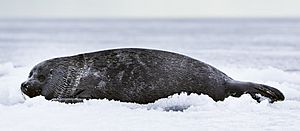
Lake Baikal is full of different kinds of life. Scientists have found over 1,000 species of plants and 2,500 species of animals. They believe there are many more to discover. More than 80% of the animals here are endemic, meaning they live nowhere else.
Plants of Lake Baikal
Many plant species grow around Lake Baikal. The marsh thistle is one example.
Most large underwater plants are not found in Lake Baikal. They only grow in some shallow bays. Instead, the lake's plant life is mostly different types of green algae. These include Draparnaldioides and Ulothrix. Many of these green algae species are unique to Baikal. Over 400 types of diatoms (tiny algae) live in the lake. About half of them are found only here.
Animals of Lake Baikal
Mammals
The Baikal seal (Pusa sibirica) is a special type of seal. It lives only in Lake Baikal.
Many land mammals live around the lake. These include the Eurasian brown bear, Eurasian wolf, and red fox. You can also find sable, elk, reindeer, and wild boar. Smaller animals like red squirrels, Siberian chipmunks, and mountain hares also live here. Long ago, European bison also lived near the lake.
Birds
There are 236 types of birds that live around Lake Baikal. About 29 of these are waterfowl. Some birds, like the Baikal teal, are named after the lake. But they actually live in many parts of eastern Asia.
Fish
Fewer than 65 native fish species live in the lake basin. But more than half of them are endemic. This means they are found only here. Three families of fish, Abyssocottidae, Comephoridae, and Cottocomephoridae, live only in Lake Baikal. These fish are usually small, less than 20 cm (8 in) long.
Two special types of fish are the golomyankas (Comephorus baicalensis and C. dybowskii). These fish have long fins and are see-through. They usually live in open water at depths of 100–500 m (330–1,640 ft). They can also be found much deeper. Golomyankas are the deepest living freshwater fish in the world. They are the main food for the Baikal seal. They also make up the largest amount of fish in the lake.
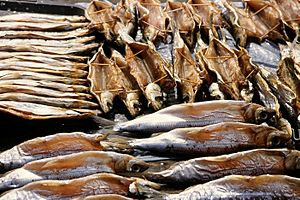
The most important fish for fishing is the omul (Coregonus migratorius). This fish is unique to Baikal. It is caught, smoked, and sold in markets around the lake. Other important fish found only in Baikal include the Baikal black grayling, Baikal white grayling, and Baikal sturgeon.
Invertebrates
Lake Baikal has many unique invertebrates (animals without backbones). The copepod Epischura baikalensis is one of them. It is the most common zooplankton in the lake. It makes up 80 to 90% of the total animal biomass. These tiny animals filter a huge amount of water each year. They can filter the lake's entire volume every twenty-three years.
Other diverse invertebrate groups include amphipods, ostracods, freshwater snails, annelid worms, and turbellarian worms.
Amphipod and Ostracod Crustaceans

More than 350 types of amphipods live only in Lake Baikal. They come in many shapes and sizes. Some are tiny, while others are quite large. Some Baikal amphipods are "giants" compared to others. This might be because the lake has a lot of oxygen. Some large, spiny amphipods like Acanthogammarus can grow up to 7 cm (2.8 in). They eat other animals and dead matter.
Baikal is also a hotspot for ostracods. About 90% of the lake's ostracods are endemic. This means there are around 200 unique species. They are the second most diverse group of crustaceans in the lake.
Snails and Bivalves
As of 2006, almost 150 types of freshwater snails are known in Lake Baikal. This includes 117 species found only here. Most of these unique snails live in shallow waters. About 30 species can be found deeper than 100 m (330 ft). Baikal snails usually have thin shells and are small.
There are fewer types of Bivalves, with over 30 species. About half of these are endemic. The unique bivalves are mostly found in shallow areas.
Aquatic Worms
Lake Baikal is home to nearly 200 types of aquatic oligochaetes (a type of worm). Over 160 of these are endemic. There are also 30 species of leeches and 4 types of polychaetes. Hundreds of nematodes (roundworms) are known, but many have not yet been officially named.
More than 140 unique flatworm species live in Lake Baikal. Most of these flatworms hunt other small animals. They are often colorful and common in shallow waters. The largest, Baikaloplana valida, can stretch up to 30 cm (0.98 ft) in deeper parts of the lake.
Sponges
At least 18 species of sponges live in Lake Baikal. About 15 of these are from a family found only here. Sponges make up the largest amount of living things on the lake bottom near the shore. Lubomirskia baicalensis and Baikalospongia species are very large for freshwater sponges. They can grow to 1 m (3.3 ft) or more. L. baikalensis often grows in branching shapes. It can form underwater "forests" where it is common. Most sponges in the lake are green when alive. This is because of tiny green algae that live inside them.
A Look at Baikal's History
The area around Lake Baikal has been home to people for a very long time. Near a village called Mal'ta, signs of human life from about 24,000 years ago have been found. One early tribe in the area was the Kurykans.
Lake Baikal was part of the Han–Xiongnu War long ago. Chinese armies chased and defeated the Xiongnu forces here. The Chinese called the lake a "huge sea" and the "North Sea." In the 6th century, the Kurykans called it "much water." Later, the Buryats called it "natural lake" and the Yakuts called it "rich lake."
Europeans didn't know much about the lake until Russia expanded into the area in the 1600s. The first Russian explorer to see Lake Baikal was Kurbat Ivanov in 1643. Russian explorers moved into the Buryat area around Lake Baikal between 1628 and 1658. They followed rivers like the Angara and Lena.
The Trans-Siberian railway was built between 1896 and 1902. Building the railway around the southwestern end of Lake Baikal was a huge task. It needed 200 bridges and 33 tunnels. Before it was finished, a train ferry carried trains across the lake. In 1918, a small battle happened on the lake during a war. In the winter of 1920, the White Russian Army crossed the frozen lake. Many people died from the cold wind during this "Great Siberian Ice March." In 1956, the Irkutsk Dam was built. This raised the lake's water level by 1.4 m (4.6 ft).
A detailed map of the lake bed was made by F.K. Drizhenko. This happened when the railway was being built.
-
A Buryat shaman on Olkhon Island.
Research and Discoveries at Baikal
Many groups do scientific research on Lake Baikal. Most are linked to the government. The Baikalian Research Centre is an independent group. It works on environmental, educational, and research projects at the lake.
In July 2008, Russia sent two small submersibles, Mir-1 and Mir-2, into the lake. They went down 1,592 m (5,223 ft) to study the lake's unique life and geology. They didn't break the record for the deepest freshwater dive. That record is held by Anatoly Sagalevich, who went 1,637 m (5,371 ft) deep in a Pisces submersible in 1990. Russian President Vladimir Putin even joined one of the Mir dives.
Since 1993, scientists have been studying neutrinos at the Baikal Deep Underwater Neutrino Telescope. This telescope is located 3.6 km (2.2 mi) from shore. It is at a depth of 1.1 km (0.68 mi).
Baikal's Economy and Tourism

Lake Baikal is often called "the Pearl of Siberia." It has attracted many people who want to invest in tourism. In 2007, the Russian government made the Baikal region a special economic zone. This helps bring in money and jobs. A popular hotel, the Mayak, is in Listvyanka. In the northern part of the lake, a German group helped build the Frolikha Adventure Coastline Track. This 100 km (62 mi)-long trail is an example of sustainable development. Baikal became a UNESCO World Heritage Site in 1996.
Lake Baikal is a popular place for tourists from all over the world. In 2014, over 146,000 foreign tourists visited the area. The most popular places to visit are Listvyanka village, Olkhon Island, and Kotelnikovsky cape. The number of visitors is growing. However, the area still needs more facilities for tourists.
The ice road to Olkhon Island is the only legal ice road on Lake Baikal. Experts prepare this road every year. It opens when the ice is thick enough. In 2015, it was open from February 17 to March 23. The ice on the road is about 60 cm (24 in) thick. Vehicles up to 10 t (9.8 long tons; 11 short tons) can use it. The road is 12 km (7.5 mi) long. It goes from Kurkut village to Irkutskaya Guba on Olkhon Island.
Ecotourism and Activities
Baikal offers different tourist activities depending on the season. There are two main tourist seasons. The first is the ice season, from mid-January to mid-April. During this time, the ice can be up to 140 centimeters thick. This allows vehicles to drive safely on the ice. Tourists can visit ice formations and caves around Olkhon Island. They can also visit small islands like Ogoy Island.
The ice itself is very clear. You can see patterns of cracks and bubbles. This season is popular for hiking, ice-walking, ice-skating, and bicycle-riding. An ice route around Olkhon is about 200 km long. Some tourists might even spot a Baikal seal. Local businesses offer overnight stays in Yurts on the ice. Ice fishing is also popular, especially on the Buryatia side of Baikal. Visitors can try fresh Baikal fish at local markets.
The ice season ends in mid-April. The ice starts to melt and becomes thin and dangerous. This can lead to accidents.
The second tourist season is summer. This is when tourists can explore Baikal's natural beauty. Hiking trails open up. Many trails cross the Baikal Mountains and Barguzin Range. A popular trail starts in Listvyanka and goes along the coast. It is 55 km (34 mi) long. Many tourists hike a shorter 25 km (16 mi) section to Bolshie Koty. This part is easy and doesn't need special skills.
Small tourist boats offer bird-watching, animal-watching (especially Baikal seal), and fishing. The lake water is usually very cold, often below 10 C. But in a few bays, like Chivirkuy, it can be warm enough for swimming.
Khuzhir village on Olkhon is a popular ecotourism spot. Baikal has always been popular with Russian and CIS-country tourists. In recent years, more visitors from China and Europe have come.
Environmental Concerns for Baikal
Environmentalists are worried about pollution in Lake Baikal. Problems include the disappearance of the omul fish. There is also a fast growth of bad-smelling algae. Unique sponge species are dying across the lake. People started speaking up about protecting the lake in the late 1950s. Since 2010, over 15,000 metric tons of toxic waste have flowed into the lake.
Baykalsk Pulp and Paper Mill
The Baykalsk Pulp and Paper Mill was built in 1966 right on the lake's shore. The factory used chlorine to bleach paper. It then released waste directly into Lake Baikal. Soviet scientists strongly protested building the plant there. They said the lake's pure water was too important. They felt it should be used for special chemical production. They also wanted to protect the unique animals and plants. And they wanted to keep the area good for recreation.
But the factory was built anyway. After decades of protests, it finally closed in November 2008 because it wasn't making money. In January 2010, production started again. President Vladimir Putin changed laws to allow the plant to operate. This caused many protests from environmental groups. Despite this, the mill finally closed for good in September 2013. Its waste ponds still pose an environmental risk.
Cancelled Oil Pipeline Plans
The Russian oil company Transneft planned to build an oil pipeline. It would have been very close to the lake. This area also has a lot of earthquakes. Environmental activists and local people were strongly against this plan. They worried about a possible oil spill. An oil spill could cause great harm to the environment.
Transneft agreed to change its plans. President Vladimir Putin ordered the company to find a different route. The new route is 40 kilometers (25 mi) north of the lake. This avoids the environmental risks. Work on the pipeline started two days after the new route was approved.
Proposed Uranium Center
In 2006, the Russian government planned to build a uranium enrichment center. It would be in Angarsk, a city about 95 km (59 mi) from the lake. Environmentalists worried this would be bad for the region. They asked the government to rethink the plan.
After uranium is enriched, only 10% of the radioactive material is sent to other countries. The other 90% would stay near Lake Baikal for storage. Uranium waste contains dangerous materials. If not stored properly, they could harm people and pollute rivers and lakes. An enrichment center was built in the 2010s.
Chinese-Owned Bottled Water Plant
A Chinese company, AquaSib, bought land by the lake. In 2019, it started building a bottling plant and pipeline. The plan was to send 190 million liters of water to China. But the lake's water levels have been very low. Local people protested, fearing the lake would be drained. The local government stopped the plans to study the issue further.
Historical Traditions and Names
The first European to see the lake was likely Kurbat Ivanov in 1643.
In the past, many Russians called Baikal the "Baikal Sea." They didn't just call it "Lake Baikal." This name was used in old writings and maps. A famous song also calls it "Glorious sea, the sacred Bajkal." Even today, the narrow water between the western shore and Olkhon Island is called Maloye More. This means "the Little Sea."
Lake Baikal is also nicknamed "Older sister of Sister Lakes." This refers to it and Lake Khövsgöl.
According to an old story, Christ once visited this area. He stood on a mountain and looked over the region. He blessed the land to the north. Then he looked south across Baikal and said, "Beyond this there is nothing." Locals used this story to explain why the land south of Baikal was not good for growing crops.
Lake Baikal is celebrated in several Russian folk songs. Two of these songs are very well known in Russia and other countries like Japan.
|
See also
 In Spanish: Lago Baikal para niños
In Spanish: Lago Baikal para niños
- List of World Heritage Sites in Russia
- Marina Rikhvanova, an ecologist who works to protect Lake Baikal
- Russian Far East
- Seven Wonders of Russia


